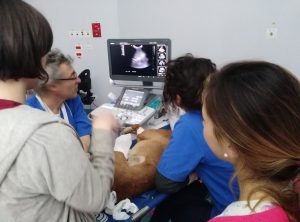Multidetector row computed tomography and ultrasound characteristics of caudal vena cava duplication in dogs
Bertolini G1, Diana A, Cipone M, Drigo M, Caldin M.
Multidetector row computed tomography and ultrasound characteristics of caudal vena cava duplication in dogs
Vet Radiol Ultrasound. 2014 Sep-Oct;55(5):521-30. doi: 10.1111/vru.12162. Epub 2014 May 16.
Abstract
Caudal vena cava duplication has been rarely reported in small animals. The purpose of this retrospective study was to describe characteristics of duplicated caudal vena cava in a large group of dogs. Computed tomography (CT) and ultrasound databases from two hospitals were searched for canine reports having the diagnosis “double caudal vena cava.” One observer reviewed CT images for 71 dogs and two observers reviewed ultrasound images for 21 dogs. In all CT cases, the duplication comprised two vessels that were bilaterally symmetrical and approximately the same calibre (similar to Type I complete duplication in humans). In all ultrasound cases, the duplicated caudal vena cava appeared as a distinct vessel running on the left side of the abdominal segment of the descending aorta and extending from the left common iliac vein to the left renal vein. The prevalence of caudal vena cava duplication was 0.46% for canine ultrasound studies and 2.08% for canine CT studies performed at these hospitals. Median body weight for affected dogs was significantly lower than that of unaffected dogs (P < 0.0001). Breeds with increased risk for duplicated caudal vena cava were Yorkshire Terrier (odds ratio [OR] = 6.41), Poodle (OR = 7.46), West Highland White Terrier (OR = 6.33), and Maltese (OR = 3.87). Presence of a duplicated caudal vena cava was significantly associated with presence of extrahepatic portosystemic shunt(s) (P < 0.004). While uncommon in dogs, caudal vena cava duplication should be differentiated from other vascular anomalies when planning surgeries and for avoiding misdiagnoses.






 Il Direttore Sanitario Dott. Marco Caldin
Il Direttore Sanitario Dott. Marco Caldin